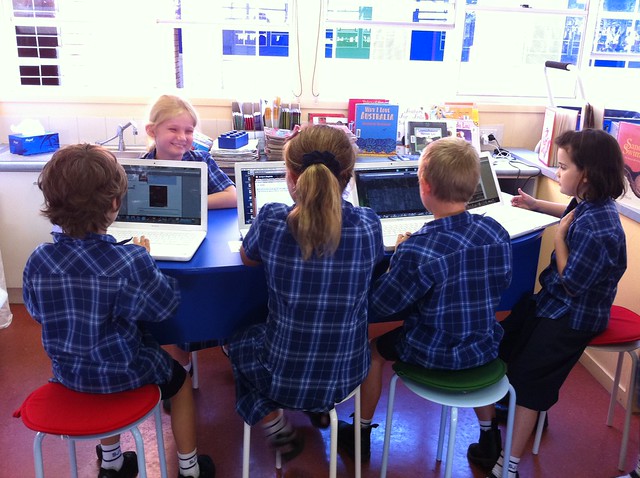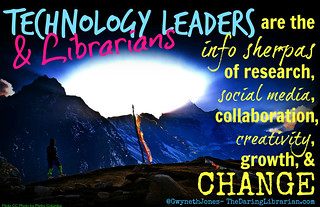My first experience with technology in the classroom was the good ol' Apple IIe and endless hours playing Oregon Trail and Math Blaster. That evolved to an after school coding club in high school where I learned how to make a square and a flower using BASIC. I got my first personal computer as a freshman in college (1998) and finally got Internet at home when I came home at the Holidays the same year.
And look at where learning is today...
The classroom is becoming less about the physical space it occupies and more about the cloud. Today, many teachers are beginning to shift their instruction from stand and deliver to more interactive, engaging and participatory styles of teaching and learning.
To add to the physical changes happening in the classroom, they way students interact with each other, both in the class and outside the class, is shifting as well. With 1:1 and Bring Your Own Device (BYOD) programs taking hold across the country (and the world) students have access to just about all known knowledge at their fingertips.
This Powering The Digital Classroom movement brings many challenges to overcome and demands several creative solutions to provide more engaging content for students, diving into how students are learning and having students reflect on how they know what they know.
Engaging Content-It is clear that students want to be more engaged with their learning. If we look at the world in which they live they are surrounded by screens, games, music and more. So why not take cues from their world and make the learning environment a bit more familiar to them? And that means more than just allowing them to use a cellphone as a calculator or a laptop to create a presentation.
Traditionally the classroom has been a place of comfort for the teacher rather than the student. Teachers-created lessons that were easy to deliver, yet for many students the lecture style of teaching that takes place in many classrooms doesn't suit this generation of learners. If you are bored teaching the content, think about how the students feel.
Digital devices have the potential to change that.
With the access to devices students can have access to a multitude of variations when it comes to their content. Teachers are no longer limited to transparencies on the overhead. Students can watch videos, examine live Tweet streams, talk to experts via Hangouts or perform virtual experiments otherwise not possible.
Understanding How Learning Works (Or Doesn't)-With the proliferation of tablets, mobile devices and laptops, students can be more connected to their learning than ever before. The use of these devices makes its easy know what students know, the moment they know it.
Formative assessments were a large part of my classroom. By the time I gave a test or a quiz at the end of a unit, it was too late. I needed to know how well my instruction was working, or more importantly, not working. Embracing formative assessments helped me do that. Through mostly non-digital means I could quickly understand if my students were struggling with concepts or if I needed to bump up my instruction because it was too easy.
Now, digital tools like virtual polling, online sticky notes and others allow us to not only guage understanding in the moment, we can record that data easily and use it to make better decisions in our classroom. We can see how student understand changes over time with the click of a button and share that information with the student so they better understand their learning as well.
I truly believe Formative Assessments have the power and the potential to radically change how instruction is done in the classroom, when the data gathered is used to inform decisions about teaching and learning.
Reflections On Learning- Since I started teaching one thing I embraced early on was reflection. It was important to me to examine how I was teaching, how well I was or wasn’t doing, and how I could improve my craft. Many times these reflections took place with the voice in head. Now they take place for the whole world to see on my blog.
Blogging is a huge part of who I am as a professional. It allows me to think out loud with whomever will listen and get their feedback and wisdom. My blog is a place for me to share new ideas, think openly about issues that matter to me and serves as a place to learn as well.
Blogging in the classroom takes many forms. From the class blog that is maintained by the teacher, to the group blog where each student has an opportunity to contribute posts, to students having their own blog to openly reflect on their learning and share their struggles with their learning.
Teachers are not the only ones who benefit from blogging. Students benefit from this type of reflection as well. Because blogging and microblogging have become so easy, and now students have access to their own devices, this type of reflection is possible. And students have a variety of platforms to choose from. Teachers are seeing blogs as a way to encourage student conversation and to open a dialogue between students.
These are exciting times to be in the classroom, whether that room is a physical space or in the cloud. When we Power Up The Classroom with Engaging Content, Meaningful Assessments and Reflections Through Blogging, we can truly leverage the digital tools at hand to create innovative and creative learning spaces.
What do you think? What will a transformation to fully digital classrooms require? Leave you thoughts below.
Photo Credit: Learning Neighbourhood 2011 via photopin (license)And look at where learning is today...
The classroom is becoming less about the physical space it occupies and more about the cloud. Today, many teachers are beginning to shift their instruction from stand and deliver to more interactive, engaging and participatory styles of teaching and learning.
To add to the physical changes happening in the classroom, they way students interact with each other, both in the class and outside the class, is shifting as well. With 1:1 and Bring Your Own Device (BYOD) programs taking hold across the country (and the world) students have access to just about all known knowledge at their fingertips.
This Powering The Digital Classroom movement brings many challenges to overcome and demands several creative solutions to provide more engaging content for students, diving into how students are learning and having students reflect on how they know what they know.
Engaging Content-It is clear that students want to be more engaged with their learning. If we look at the world in which they live they are surrounded by screens, games, music and more. So why not take cues from their world and make the learning environment a bit more familiar to them? And that means more than just allowing them to use a cellphone as a calculator or a laptop to create a presentation.
Traditionally the classroom has been a place of comfort for the teacher rather than the student. Teachers-created lessons that were easy to deliver, yet for many students the lecture style of teaching that takes place in many classrooms doesn't suit this generation of learners. If you are bored teaching the content, think about how the students feel.
Digital devices have the potential to change that.
With the access to devices students can have access to a multitude of variations when it comes to their content. Teachers are no longer limited to transparencies on the overhead. Students can watch videos, examine live Tweet streams, talk to experts via Hangouts or perform virtual experiments otherwise not possible.
Understanding How Learning Works (Or Doesn't)-With the proliferation of tablets, mobile devices and laptops, students can be more connected to their learning than ever before. The use of these devices makes its easy know what students know, the moment they know it.
Formative assessments were a large part of my classroom. By the time I gave a test or a quiz at the end of a unit, it was too late. I needed to know how well my instruction was working, or more importantly, not working. Embracing formative assessments helped me do that. Through mostly non-digital means I could quickly understand if my students were struggling with concepts or if I needed to bump up my instruction because it was too easy.
Now, digital tools like virtual polling, online sticky notes and others allow us to not only guage understanding in the moment, we can record that data easily and use it to make better decisions in our classroom. We can see how student understand changes over time with the click of a button and share that information with the student so they better understand their learning as well.
I truly believe Formative Assessments have the power and the potential to radically change how instruction is done in the classroom, when the data gathered is used to inform decisions about teaching and learning.
Reflections On Learning- Since I started teaching one thing I embraced early on was reflection. It was important to me to examine how I was teaching, how well I was or wasn’t doing, and how I could improve my craft. Many times these reflections took place with the voice in head. Now they take place for the whole world to see on my blog.
Blogging is a huge part of who I am as a professional. It allows me to think out loud with whomever will listen and get their feedback and wisdom. My blog is a place for me to share new ideas, think openly about issues that matter to me and serves as a place to learn as well.
Blogging in the classroom takes many forms. From the class blog that is maintained by the teacher, to the group blog where each student has an opportunity to contribute posts, to students having their own blog to openly reflect on their learning and share their struggles with their learning.
Teachers are not the only ones who benefit from blogging. Students benefit from this type of reflection as well. Because blogging and microblogging have become so easy, and now students have access to their own devices, this type of reflection is possible. And students have a variety of platforms to choose from. Teachers are seeing blogs as a way to encourage student conversation and to open a dialogue between students.
These are exciting times to be in the classroom, whether that room is a physical space or in the cloud. When we Power Up The Classroom with Engaging Content, Meaningful Assessments and Reflections Through Blogging, we can truly leverage the digital tools at hand to create innovative and creative learning spaces.
What do you think? What will a transformation to fully digital classrooms require? Leave you thoughts below.










